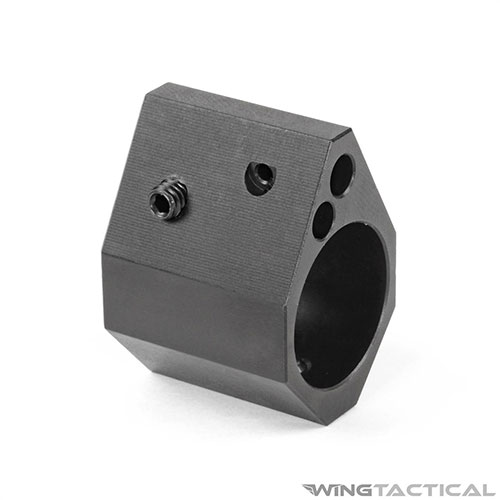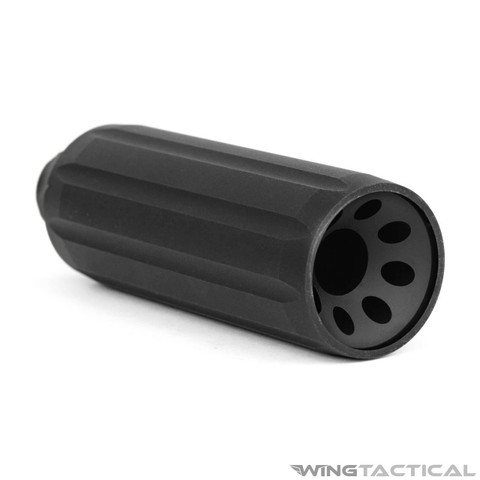If you’re looking for an adjustable AR-15 gas block for your next custom-built project, you’ve come to the right place. Wing Tactical carries an array of high-quality adjustable gas blocks from numerous manufacturers. Explore our selection and start your build.

Adjustable Gas Blocks for AR-15
Adjustable gas blocks give shooters more control over their gas system’s performance — and make it easy to tweak the gas system as needed.
Generally, there are two types of gas blocks that you can install in your AR rifle. Some can be adjusted dynamically across a spectrum, and some have predetermined positions like “open” and “restricted.” Where dynamically adjustable gas blocks allow you more control over fine-tuning your gas system, those with dedicated positions are usually easier to adjust on the fly and work quite effectively.

Gas Blocks
Gas blocks are a key component of your rifle’s gas system — the set of components that harnesses the power of combustion gases to cycle your firearm. While a stock AR-15 might not feature one, an adjustable gas block gives you additional control over your gas system and rifle’s performance.
Wing Tactical: Top-Quality Components and Service
Wing Tactical is dedicated to providing high-quality products and exceptional customer service to today’s firearm enthusiasts. We don’t stock anything we wouldn’t use ourselves — that’s why you can always rely on the products in our inventory.
Anytime you need help choosing a product, have a question about compatibility, or simply want to chat with a gunsmith, reach out to our dedicated customer service team. We’re excited to help you bring your next custom build to life.
Frequently Asked Questions
What does the gas block do?
The AR-15 is a gas-operated rifle. It uses a direct impingement gas system: the expanding gases from the barrel are redirected by the gas block through the gas tube and onto the bolt carrier gas key, which unlocks the bolt and allows it to move back, re-cocking the hammer for the next shot on the way back.
How does the gas system affect your rifle’s performance?
The gas block is a vital part of the AR-15 operating system, and it can affect your rifle's performance in many ways.
With non-adjustable gas blocks, the gas port's placement on the barrel and the gas port's size determines how the system will behave. For example, your system might be under-gassed if the gas port is too far from the chamber. As a result, the rifle may not redirect enough gas to cycle the gun reliably.
On the other hand, if it is too close to the chamber, you may be letting too much gas into the chamber, which can damage the internal components of your rifle. Moreover, an over-gassed AR will also get dirty quickly because of the direct impingement operating system.
You can find the optimal spot to place the gas block on the barrel depending on the barrel length and the caliber your AR is chambered in. However, the problem is that several factors can increase or decrease the level of gas circulating in your system, and a fixed, non-adjustable gas block cannot adapt to all of these situations.
For instance, if you are shooting subsonic ammunition, the redirected gas may not be enough to cycle the rifle, or if you add a suppressor, you may end up over-gassing your rifle. Both situations can cause problems for the reliability and effectiveness of your rifle.
How does an adjustable gas system work?
An adjustable gas block does not only redirect the gases from the barrel to the gas tube but also acts as a valve, increasing or decreasing the size of the gas port to control the amount of gas that enters the system.
Why is an adjustable gas system better?
An adjustable gas system is very practical and allows you to adjust your gas setting on the fly and optimize your rifle for shooting in various situations. For example, if you are shooting low-powered ammunition, or your rifle has a lot of dirt and carbon build-up due to excessive use in the field, you can increase the amount of gas moving into the chamber. On the other hand, if you are using a suppressor, you can decrease the gas settings to compensate for the increased gas pressure.
How tightly should a gas block fit?
Gas blocks should fit closely with both the barrel and the gas tube; most gunsmiths recommend fitting them snugly without overtightening.






